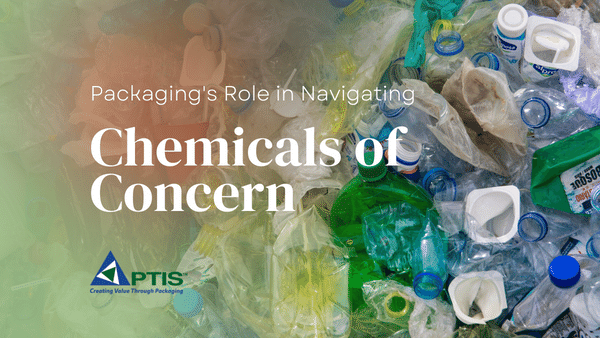Contributed by Michael Richmond, PTIS Principal and Jerrett Gogola, Sr. PTIS Associate
Reacting to new legislation and public pressure regarding chemicals of concern in packaging has been a nearly constant initiative for brands and packaging companies alike the past 20 years. The EPA’s Chemicals of Concern (COCs) is a list containing chemical substances found to be toxic to human health and the environment.
If you’re involved with the packaging for the consumer products industry, you’re likely already aware of some of the most widely known offenders, such as BPA, PFAS, and Phthalates. If these terms are new to you, your business may be at risk of being out of compliance with the law and/or your customer’s requirements.
Impacts Lag Adoption
It’s critical for stakeholders responsible for selecting packaging to ensure compliance with the laws and to put forward safe, non-toxic, packaging components. In the same way product developers need to ensure ingredients are safe for consumption and those involved with selecting packaging must validate these components are not adversely affecting public health and/or the environment. COC’s have potential to build up in the environment and migrate into the products we consume. Human health impacts range from COC’s include links to cancer, reduced ability to fight infections, obesity, and impaired brain development, to name a few. The science of understanding these harmful impacts often lags the adoption of the innovations into the marketplace. This creates situations for participants to find viable alternatives that are not more harmful within timelines set by customers or regulators. To be viable, the alternatives must satisfy cost, functionality, and operational requirements. For this reason, addressing COC’s in packaging should be top of mind for all functions involved, not just R&D, procurement, and supply chain.
PFAS
The most prevalent example of current COC regulation is PFAS. PFAS (Per or Polyfluoroalkyl Substances) are a class of chemicals that include literally thousands of different compounds with varying functionality and migratory risks. However, in the most recent US regulation, nuance is not in the forefront as all PFAS chemicals are being treated the same. Essentially, if it has a single fluorinated carbon atom, it falls into this restricted category. PFAS have been dubbed “forever chemicals” because the carbon-fluorine bond is very strong. The bond resists degradation and accumulates in the environment and in our bodies. Functionally, they’re incredibly useful and cost-effective.
Unknown to most packaging professionals prior to last year, PFAS are ubiquitous in the industry. Most associations are with paper-based takeaway containers – think fast food hamburger cartons, paper french fry pouches, and pizza boxes. In fact, the first states to ban PFAS packaging (California and New York) focused their legislation solely on paper-based packaging. They make no mention of other substrates, such as metals and plastics, where PFAS area also heavily utilized as process aids. Other states, like the upcoming bans in Vermont and New Hampshire, are much less specific when it comes to packaging materials. All regulations, no matter from the state or the FDA, are ambiguous and leave it to stakeholders to balance legal risk with write-offs, recalls or product cuts because of the individually state-led timelines.
Whether PFAS or not, engage early and often with your regulatory team to understand what’s next. Additionally, consider developing and implementing a cross functional anticipatory chemicals of concern in packaging team.
With regulations already enacted, it’s critical for brand owners and packaging converters to engage with their suppliers all the way down the chain to determine if and why PFAS and other potential chemicals of concern are being utilized.
Contact PTIS to discuss your packaging strategy.
—
About Jerret Gogola
Jerrett Gogola, PTIS Sr. Associate is a packaging leader with 15 years of experience supporting some of the largest brands in the food industry. During his professional career, Jerrett has held a variety of roles that have focused on increasing efficiencies, streamlining processes, developing strategic innovation, and he even spent a year in a formal marketing capacity as an Associate Brand Manager. Jerrett’s strong business acumen and diverse technical experience enables him to communicate clearly across silos, ensuring projects are delivered on-time and on-budget. He earned an MBA from Drexel University and a B.S. in Packaging from Michigan State University.


